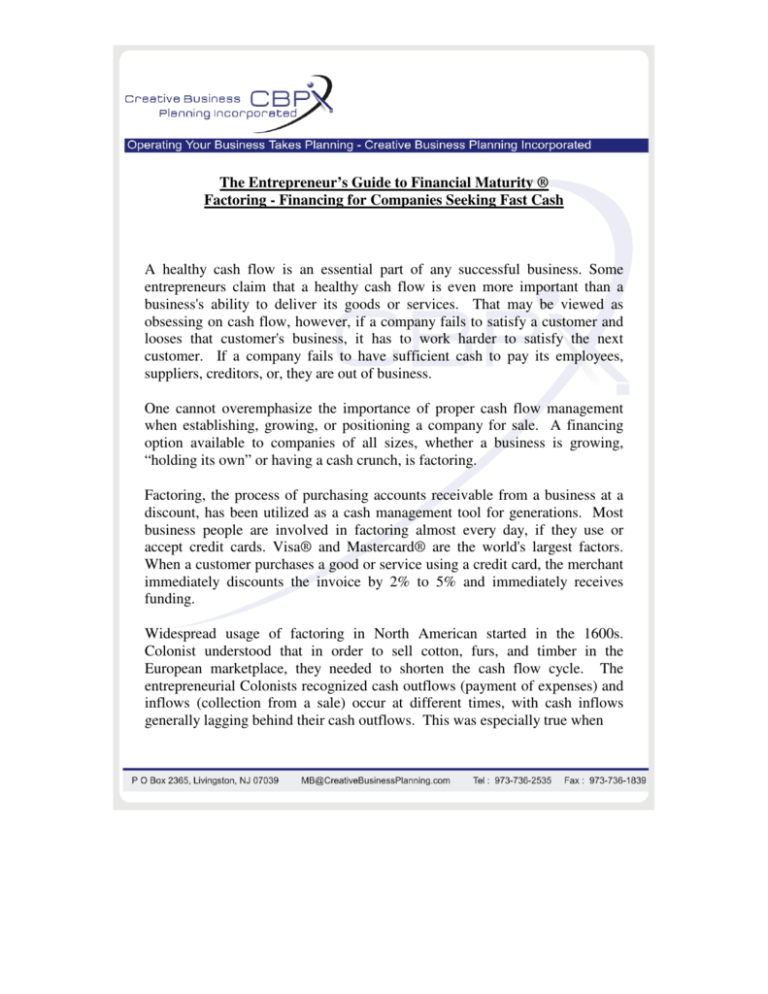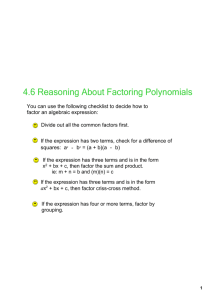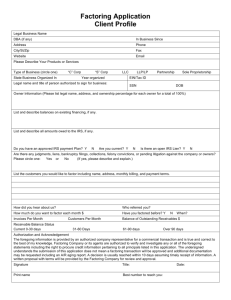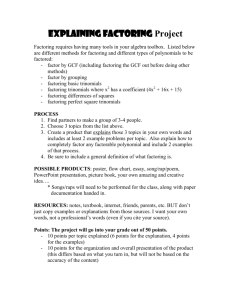
The Entrepreneur’s Guide to Financial Maturity ®
Factoring - Financing for Companies Seeking Fast Cash
A healthy cash flow is an essential part of any successful business. Some
entrepreneurs claim that a healthy cash flow is even more important than a
business's ability to deliver its goods or services. That may be viewed as
obsessing on cash flow, however, if a company fails to satisfy a customer and
looses that customer's business, it has to work harder to satisfy the next
customer. If a company fails to have sufficient cash to pay its employees,
suppliers, creditors, or, they are out of business.
One cannot overemphasize the importance of proper cash flow management
when establishing, growing, or positioning a company for sale. A financing
option available to companies of all sizes, whether a business is growing,
“holding its own” or having a cash crunch, is factoring.
Factoring, the process of purchasing accounts receivable from a business at a
discount, has been utilized as a cash management tool for generations. Most
business people are involved in factoring almost every day, if they use or
accept credit cards. Visa® and Mastercard® are the world's largest factors.
When a customer purchases a good or service using a credit card, the merchant
immediately discounts the invoice by 2% to 5% and immediately receives
funding.
Widespread usage of factoring in North American started in the 1600s.
Colonist understood that in order to sell cotton, furs, and timber in the
European marketplace, they needed to shorten the cash flow cycle. The
entrepreneurial Colonists recognized cash outflows (payment of expenses) and
inflows (collection from a sale) occur at different times, with cash inflows
generally lagging behind their cash outflows. This was especially true when
¾
¾
goods were being shipped to Europe. The long collection cycle left the
Colonist in a dilemma, should the Colonial entrepreneur:
¾Stop shipping to Europe, thereby limiting the size of the business’s
market and potential profitability
¾Find a financial partner and potentially loose control over the business
¾Find other solutions
Many Colonists looked to European Merchant Bankers to advance funds
against the receivables, thereby providing the enterprise with cash to continue
operations.
Many of today’s entrepreneurs face similar cash flow issues. Many
companies, especially small businesses, are unable to obtain bank loans, since
many are undercapitalized, have a negative net worth and a history of losses.
These companies may have accounts receivables that can be financed, thereby
providing resources enabling the entrepreneur to focus on implementation of
the business plan, not on crisis management.
Factoring is prefect for companies that are fast growing, or companies looking
to seize market opportunities. By using factoring, the entrepreneur can meet
increasing sales demands. It is almost impossible to outgrow a factor’s credit
facility, whereas fast growing companies do outgrow bank and other lending
institution credit facilities. Outgrowing a credit facility is disruptive; it will
strain a company’s resources and will be detrimental to the company’s
financial condition. An entrepreneur’s ability to factor is based upon the
amount of qualified receivables, and not limited to the line of credit.
Factoring allows a company to obtain financing without selling part of the
company. Factoring should be viewed as a bridge to growing a company, an
interim step to obtaining a traditional credit facility or an equity capital.
Conventional financing will substantially reduce the company’s financing
costs.
Alternatively, if a company is having cash flow problems, factoring should be
viewed as a method to “buy time” to correct cash flow problems. Otherwise,
the entrepreneur may have to sell part of his/her company, in a distress sale, or
face the prospect of going out of business due to lack of funds.
As we all know, cash flow problems can cripple a business resulting in
temporary cash crunches with the inability to pay employees, trade creditors
and suppliers. Everyday operations suffer because management’s focus is
shifted away from operations to collecting receivables on current and past due
invoices. Typically, sales, morale and productivity suffer. Factoring reduces
these cash crunches and enables the entrepreneur to pay bills in a timely
manner, enabling the entrepreneur to build their credit score. Good credit can
translate into obtaining conventional financing quicker. Factoring also enables
a business to improve its Balance Sheet, further increasing the likelihood of
qualifying for conventional financing.
Factoring has helped tens of thousands of entrepreneurs build value in their
companies. Many entrepreneurs delayed selling their companies, bringing in
new partners, shareholders, or other capital, specifically because they could
retain more equity in their business. Most of the time, factoring can be without
any personal guarantees (non-recourse). On the other hand, most conventional
lenders will require a small business owner to be “at risk” and guarantee a
credit facility.
Since factors typically control the billing and collection of invoices factored, a
business’ customers will know that the receivables are being factored. Many
entrepreneurs are concerned as to what their customers will think if receivables
are factored.
Will the customer view factoring as a sign of financial weakness? These
concerns can be addressed easily, by looking at the services factors provide.
Factoring provides for the professional collections of accounts receivable,
therefore, they are more effective than the bookkeeper or untrained person.
Factors are not in the business to harass or coerce a customer to pay, they want
to assist the entrepreneur maintain their relationship, after all, the factor wants
to continue to purchase those receivables.
The factor can be a customer relations manager, for example, before the factor
funds a receivable, the factor will call the customer to verify that the order was
shipped out, and that the quality of the service met or exceeded the client’s
expectations. When there are quality control or delivery issues, the factor is
made aware of it, and this information is immediately conveyed to the
entrepreneur. As a result, problems tend to be addressed at an earlier point in
time, before the entrepreneur looses the client.
Factors accelerate the collection process. For example, many companies have
two accounts payable departments, one for companies that factor (and report
slow paying customers to credit rating agencies) and a separate department for
bills that are not factored. Invoices that are factored are generally paid faster,
especially when customers are experiencing their own cash flow problems.
Faster paying customers translates into reduced factoring costs.
The entrepreneur using a factor specializing in their industry or similar
industries can take advantage of their market knowledge, and can serve as an
early warning system for customer credit problems. Factors screen your
customers’ credit, monitor it, and will not want to be at risk if a customers’
financial position deteriorates. Factors reduce the entrepreneur’s bad debts.
Factoring is utilized to strengthen the company.
Many entrepreneurs do not consider factoring because of its “out of pocket
costs”, ignoring opportunity costs. Too often the entrepreneur will begin the
factoring decision by looking at factoring discounts (the percentages of the
factor will pay for a receivable) on an annualized basis, like a car loan or a
mortgage. An entrepreneur may take a discount of say 3%, and annualize it
(multiply by 12) and assume they cannot afford to pay 36% per annum to a
factor.
Many entrepreneurs are focused on what’s going into someone else’s pocket,
ignoring the economic benefits entrepreneur receives. For example, can a
retailer that doesn’t factor (accept credit cards) effectively compete against a
retailer that accepts credit cards? In today’s economic environment, can a
retailer that does not factor become a national chain? Will it thrive? Will it
barely survive? Will it fail? Obviously, definitive calculations of opportunity
costs are impossible. However, if we make reasonable assumptions, such as
those shown below, a compelling case can be made for factoring.
Monthly Profit and Loss
Without Factoring
With Factoring
Estimated Monthly Gross Sales
$
50,000 100% $
100,000
100%
Cost of Goods Sold
$
35,000
70% $
70,000
70%
Estimated Monthly Gross Profit
$
15,000
30% $
30,000
30%
Fixed Costs
$
10,000
20% $
10,000
10%
Variable Costs
$
5,000
10% $
10,000
10%
Factoring Fee
$
0% $
3,000
3%
Total - Pre Tax – Expenses
$
30% $
23,000
23%
0% $
7,000
7%
Estimated - Pre Tax - Monthly Net Profit $
15,000
-
Utilizing this simple calculation based upon reasonable assumptions, it would
indicate that this company could barely stay afloat without factoring. With
factoring, and the increase in sales, the company is very profitable. This
calculation does not assume any cost savings attributable to purchase discounts
or any other favorable terms one can negotiate when a company can pay its
suppliers immediately.
Why is factoring so expensive? Unlike long term financing, each receivable
purchase is short term and labor intensive. Factors provide services that
traditional lenders do not: credit screening, credit monitoring, invoice
processing, customer relationship management, absorption of credit risks,
while providing the entrepreneur comprehensive reporting. These services
frequently enable the entrepreneur to reduce his/her overhead. Factoring is
volume driven, the more you factor, the lower the costs.
Ultimately, the decision to factor is a business decision. What are the benefits
of this money if it is going to cost 2%, 3%, 4% or more? Most entrepreneurs
weigh the costs of factoring against the costs of not factoring. Most often the
decision is between factoring and putting up with cash flow problems. If the
entrepreneur looses sales opportunities, or backlog order are canceled because
of the entrepreneur’s ability to deliver due to a lack of cash flow, this will
decrease a company’s growth and profitability.
Generally, documentation required to factor is simple. The entrepreneur
begins by filling out a client profile containing such information as the
company's name and address, the nature of the business, and customer
information. The entrepreneur will be required to supply an accounts
receivable aging report, existing customers' credit limits, or other related
documents. The factor will attempt to determine the clients’ creditworthiness
independently. The factor conducts due diligence by researching the
entrepreneur’s customers' credit and any liens placed against the entrepreneur’s
company.
During this initial stage the entrepreneur will also cover basic financial
arrangements with the factor. For instance, estimated monthly volume of
invoices to be factored, estimated advance rate and the discount rate and how
many days after approval will it take the factor to fund. In most cases, the
answers to these questions will vary depending on the financial strength of the
receivables and the anticipated monthly sales volume to be factored. For
example, a long list of high-risk clients will cost more in factoring fees than a
short list of government agencies with a slow-pay history.
A question that continually arises is “Should the entrepreneurs use a financial
intermediary for factoring?” Intermediaries generally help the entrepreneur
obtain financing faster, by:
¾Identifying the right factor and directing the company to it
¾Providing a higher comfort level
Assembling a professionally prepared financial package, allowing the
transaction to close quicker
Further, intermediaries often act as the eyes and ears of the factor and therefore
factors feel more comfortable. The intermediary provides deal flow to factors,
and therefore an entrepreneur will pay the same or less for deals they bring in.
Most importantly, the intermediary’s presence in factoring, negotiation and the
process provides the entrepreneur with a comfort level to complete the
transaction.
During the negotiation process, the entrepreneur will become aware of the cost
of factoring accounts receivable. After an agreement is reached with the
factor, funding begins. The entire process can take less than 10 days from the
factor’s receipt of application.
Financial Maturity ® is a registered trademark owned by Morris Bocian. Copyright © 2000 - 2005
Creative Business Planning Incorporated. All rights reserved. All information is from sources deemed
reliable. Such information has not been verified and no express representations are made nor implied as
to the accuracy thereof, and it is submitted subject to errors and omissions, and is subject to change or
withdrawal without notice.









